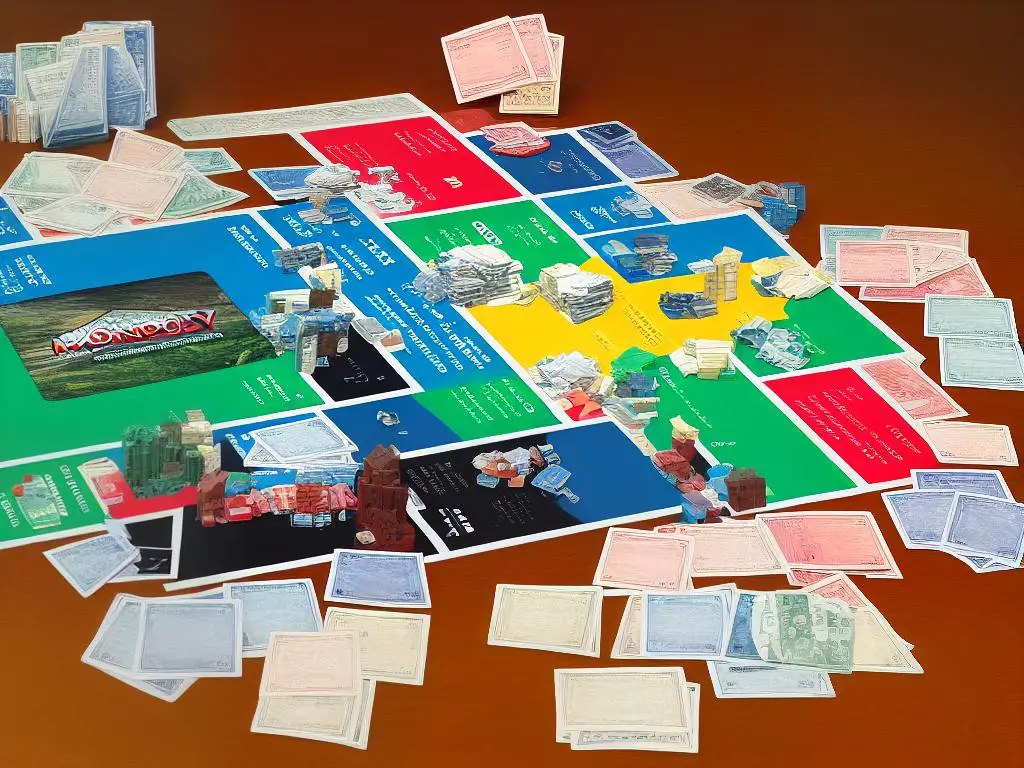Immerse yourself in the dynamic and competitive world of Monopoly Deal, a fast-paced, card-based variant of the classic board game that challenges your strategic planning and deal-making abilities. This guide will enlighten you on the different game components, from property and money cards to action cards, and their respective vital roles in the game’s progression. We will also delve into the official game rules, common game situations, and the flow of a typical turn. Towards the end, the focus will shift towards honing your tactics to increase your chances of victory, from knowing when to deploy certain action cards, efficient property set building, to effective ways of impeding your rivals’ progress. Let’s get started on this exciting journey towards becoming a Monopoly Deal champ!
Understanding the Game Components
Understanding Monopoly Deal Components
Monopoly Deal is a fast-paced game where the goal is to collect three property sets to win. Like in classic Monopoly, players navigate different types of cards to strategize their winning approach. The card types consist of property cards, money cards, and action cards. Here’s an overview of their individual functionalities:
Property Cards
Property cards serve as the central foundation of your Monopoly Deal empire; your ultimate goal is to accumulate three full sets of these cards. There are 28 property cards in the game with different colors signifying different properties, much like Monopoly’s traditional colored property spaces.
Each property card has a value shown in the top left corner and a color that indicates which set it belongs to. Collect all the properties in a single color to complete a set. Some cards include properties that are part of a two-card set, while others may require three or four to complete.
Money Cards
Money cards play a fundamental role in Monopoly Deal. These cards can be used as bank money stored flat under the bank pile or to pay other players when necessary. Just like real money, these cards come in different denominations (from 1M to 10M). While money may seem less important than property cards initially, having a substantial amount stacked in your bank is essential in thwarting action card attacks from other players.
Action Cards
Action cards are where the game starts to get exciting and strategic. They allow players to perform various actions like charging players rent, stealing their cards, or cancelling another player’s action. Each action card has a value in the corner that represents its monetary worth when played into a player’s bank.
“Rent” cards allow a player to collect rent from another player based on the property sets they have in their possession. “Pass Go” cards allow a player to pick up two additional cards from the deck, while “Deal Breaker” cards enable a player to take another player’s complete property set.
Each action card also has detailed instructions on its usage, so be sure to read them carefully before making your move.
Remember, how you utilize each property, money, and action card can drastically change the course of your game. Deciding when to save or spend, steal or trade, and protect or attack with your assets can make the difference between winning big or going bankrupt. The strategic use of these cards is what makes Monopoly Deal an exciting, competitive, and highly addictive card game. So, get familiar with your game components and prepare to deal your way to victory.

Learning Rules and Game Flow
Introduction: Mastering Monopoly Deal
Monopoly deal is an exciting card game version of the classic monopoly board game. The objective is to be the first player to acquire three full property sets. An array of action cards adds variety and unpredictability to the game.
Understanding the Cards
Before starting, it’s essential to familiarize yourself with the four types of cards in Monopoly Deal: Property, Money, Action, and Wild Property.
Property Cards
These are your primary assets in the game. They come in different colors representing various property sets. Each set has a different number of properties.
Money Cards
This card type is used for paying debts, charged by other players or by action cards. It is also used as a shield against any monetary losses.
Action Cards
Action cards represent various powerful actions that can mix up the game. For instance, some allow the player to steal properties, charge players for rent, or cancel actions.
Wild Property Cards
These cards can be included in any color sets, allowing for strategic flexibility.
Setting up the Game
- Shuffle the deck and deal five cards to each player.
- Place the rest of the deck in the middle of your playing area – this will be your draw pile.
- Keep an open space next to the draw pile for discarded cards – this is your discard pile.
Basic Gameplay Flow
Each player’s turn consists of three distinct steps.
Draw Phase
At the beginning of your turn, draw two cards from the draw pile.
Action Phase
Next, play up to three cards from your hand. There are a few options here: you can use money cards by placing them into your bank, place property cards onto the table to start collecting sets, or execute action cards.
Cleanup Phase
At the end of your turn, you need to reduce your hand down to seven cards if you have excess cards. Any excess cards are placed in the discard pile without getting used.
Winning the Game
To win Monopoly Deal, you need to collect three full sets of different colored property cards. A set is considered ‘full’ when all spaces specified on the card are filled – this differs for each colored set.
A few key points to note:
- You can only use action cards during your turn and within the action phase.
- Remember to use your action cards wisely, as they can significantly affect the game flow.
- Lastly, keep an eye on your opponents’ properties to prevent them from getting three full sets before you do.
With these fundamental instructions, you’re on track to become a Monopoly Deal master!

Developing Strategies
Understanding the Basic Rules of Monopoly Deal
Before jumping into strategies, it’s essential to understand the basic rules of Monopoly Deal. This game is a streamlined, card-based version of its namesake board game. Each player starts with five cards in their hand, and they can play up to three cards on their turn. The game’s ultimate goal is to acquire three complete property sets of different colors. You can do this by playing property cards, swapping properties with other players, or stealing their properties.
When to Play Certain Action Cards
An important element of strategizing in Monopoly Deal involves using your action cards at opportune moments. These include ‘Just Say No!’ to block an action from another player, ‘Sly Deal’ to snatch up a property, or ‘Deal Breaker’ to nab a whole set.
For instance, ‘Deal Breaker’ is a powerful card that can be a game-changer. But it’s best used towards the end of the game. Ensure to keep an eye on the draw pile because once it’s out, players don’t get to replenish their hand. You wouldn’t want to waste your ‘Deal Breaker’ on a property set that doesn’t lead directly to victory.
Efficiently Building Property Sets
It’s important not to rush when assembling property sets. Play your property cards down as you get them. By doing so, you both decrease the amount of cards in your hand and make yourself a less inviting target for theft or forced deals. Saving them in your hand, hoping to have a full set to put down at once, often leaves you vulnerable to the ‘It’s My Birthday’ card, which allows other players to take two cards from you.
Another related strategy is to not complete your property sets too quickly. A full property set is vulnerable to ‘Deal Breaker’ card, which can swipe away the entire set at once. So, consider keeping a property or two in hand to play after an opponent has exhausted their deal breakers.
Thwarting Other Players’ Progress
In Monopoly Deal, your progress is important but so is hindering your opponents’ advancement. Keep an eye on what sets they’re trying to complete and hold onto cards that you know can help them. Also, make sure to use ‘Just Say No!’ cards to prevent other players from stealing your properties or sets.
Action cards like ‘Sly Deal’ or ‘Forced Deal’ are perfect for interrupting the progress of your competitors. These cards allow you to exchange or outright steal properties, potentially ruining an opponent’s strategy and bolstering your setup.
Remember, Monopoly Deal is a game of strategy, luck, and timing. Adapting to the flow of the game, staying aware of the cards you hold, and keeping a keen eye on your opponents’ moves can all factor in securing a win.

The challenging, yet exhilarating game of Monopoly Deal calls for strategic acumen, anticipation, and sometimes, a bit of good fortune. By now, you should be much more knowledgeable about the different types of game components, have a thorough understanding of the rules, and apply a range of strategies to turn the tide in your favor. Remember, it’s not just about amassing properties, but also making well-thought-out decisions and thwarting your competitors’ plans. With continuous practice and employing the knowledge gained from this guide, soon you’ll be winning those matches with a great deal of satisfaction. So, shuffle that deck and deal the cards, because it’s time to put your newfound skills and strategies to the test!
